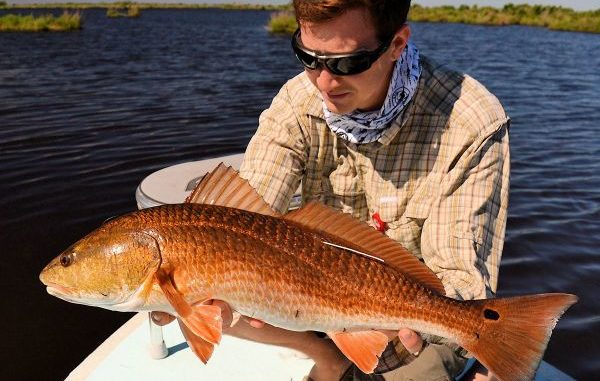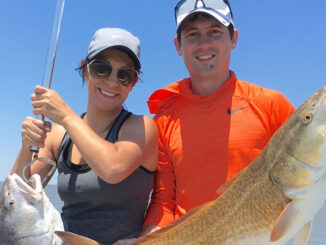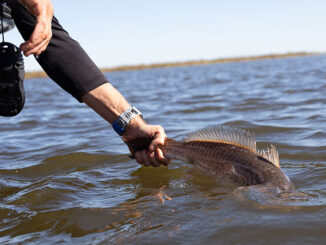
‘Tis the season to be sightcasting
Holidays have always been feastivals for the Cormier clan. Every Thanksgiving and Christmas, my family and my sister’s family would gather at our parent’s home to enjoy a vast array of culinary delights.
Lined up on the serving table was some combination of venison, duck, goose, or turkey (all taken from the wild), along with pork roast and ham. Complementing the meats were salads, lima beans, sweet potato casserole, cornbread dressing, corn machoux, field peas and various breads. And lots of rice for all that dark gravy.
And then there was dessert. My mother still makes the best pumpkin pie I’ve ever eaten. And, as Mrs. Catch can testify, I’ve eaten way too many pies.
Orange, big and round, that pumpkin pie caught my eye every time I scanned that table. There was no way it would avoid it’s destiny — with me.
The holiday season also brings another kind of pumpkin to mind — the kind that roams our marsh waters.
I’m not sure who coined the term “pumpkin” for redfish. The species Sciaenops ocellatus certainly isn’t lacking for nicknames. But one thing is sure: There are times when this name fits better than any.
Now is that time.
Cool water holds less organics and suspended sediments than warm water. This is the reason why, beginning in fall, we observe clearer water in the lakes, bayous and canals in the coastal zone.
Clearer water favors flies, as reds and other species turn more to sight than sense of smell when feeding. A fly with action can draw attention from fish several feet away.
Clear water also favors sightcasting. Against the dark background of marsh mud, a red will appear like a pumpkin — big, orange and round. Like the one Mom uses for her pies.
But clear water also presents challenges.
There’s a tendency for newbie flyfishers to spot a fish and lose composure. The term “red fever” applies. Often the result is a rushed cast, either way short, way off target or, worst of all, overpowered and “lining” the fish.
Here’s a technique I recommend for newbies: Instead of casting at the fish, determine the direction in which the fish is moving, and cast 8 to 10 feet ahead of the fish and slightly past the projected target. If the cast isn’t good, you’ve got a few seconds to recast correctly.
As the fish approaches the intercept point, strip your fly in so it crosses his path several inches in front of his nose. If the fish is “backing,” several inches are enough. If the fish is “tailing,” it might require as little as an inch or 2 to get his attention.
Another challenge with clear water is fly action.
In murky water, if the Spottail Elvis sees the fly, a strike often results, as the fish knows his meal could disappear in a second.
In clear water, the fish has a chance to examine the fly. As one of my guide friends tells it, his winter redfish know how to spell “Orvis.”
Flies with motion — ones that wobble, spin, pulsate, flow — will get a pumpkin’s attention and, in clear water, hold it. Little wonder that the best late fall and winter flies include spoonflies, clousers, charlies, seaducers and sliders. Two more favorite patterns this time of year are the Whitlock Baitfish and Apte Tarpon Fly.
Fly color is also important in late fall and winter. I’ve had many days when neutral and dark colors got eaten when the exact same fly in chartreuse was totally ignored. Keep the chartreuse, but have other colors handy, as well.
Pumpkins are never leader shy, but with clear water I still prefer to go with a slightly longer leader — up to 10 feet — and a fluorocarbon tippet.
When building leaders with fluoro, or even a mono/fluoro combination, it’s important to use connecting knots that don’t slip. My preference is the double Uni Knot. There are several videos on YouTube that demonstrate this knot. Learn to tie it using decorative cord (found at most hobby stores) until it becomes second nature.
The biggest challenge with clear-water pumpkins is stealth. If you can see them, they can see you. Even though you have polarized sunglasses and they don’t.
Gary Borger is one of our sport’s most-revered experts when it comes to presentation. Borger suggests that, while the fish may have spotted you, it’s not until he sees your movement that he senses danger.
My younger son Jacob is a master of stealth casting. He’ll spot a pumpkin and become a statue. He’ll then slowly rotate his fly rod 90 degrees to his body, in a position low enough where it’s outside the fish’s cone of view. Then, using only his wrist, he’ll cast the fly.
This technique is not something you just go out and do. It takes lots of practice before you hit the water. To quote Henry Hartman, “Success is when preparation meets opportunity.”
There is much to be thankful for this holiday season —including some of the best marsh fly fishing of the year. Get into the action every chance you have.


